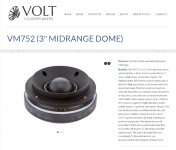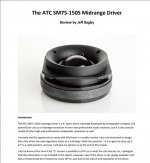Thats the reason why the best audio systems are adopted at homes and there they reproduc the finest sounds, not in a sterile environment audio show.Room acoustics and space make a huge difference. I've been lucky enough to experience many different listening and performing spaces, often with the same speakers (touring). The differences are major and often more important than the speaker.
Once I helped in an audio fair high end exhibition to prepare the room for the speaker, that we all knew too well and that were stunningly musical.
We were one of the very few that prepared and modded the room acoustics and later became "Best sound of the show" award afterwards. It took a whole day from morning to evening to prepare the room, bring in the equipment and fine tune it all acousticly. We had to fight with problems never expected before and the solutions weren't easy to find.We had no automated measuring system, that wasn't easy to obtain some 25 years ago. We had knowledge and experience and both was greatly enhanced after the show. The speakers played in a near ideal acoustic treated room, but much less damped than before so they sounded different to the environment before. I don't prefer overdamped rooms nowadays, but one has to know how to handle a room and the energy that a big horn speaker project into the room. Its not an easy task.
Last edited:
I find it's interesting that I sometimes feel that larger ATC studio monitors sound like high efficient horn speakers despite of their very low efficiency. I guess ATC's forward soundstage (a little more in your face presentation) due to mid dome and/or sharp edge of the enclosure makes me feel so. Tasteful voicing, I would say.
Your comment made me think of one of the best speakers I've ever heard, which was 15 years ago. It was a PMC monitor with (I'm pretty sure) the ATC mid dome and a volt 10" or 12" in a TL. It was natural with warmth, and tons of detail. Driven by a Bryston amp.
That's how I aim for my horns to sound.
Cheers,
Rob.
Exponential, usually. 😛Which begs the question, is your horn exceptional?
Oh, no. Good high efficiency doesn't sound like anything but what it should sound like. What you suggest reminds me of bad piezos.I find it's interesting that I sometimes feel that larger ATC studio monitors sound like high efficient horn speakers despite of their very low efficiency. I guess ATC's forward soundstage (a little more in your face presentation) due to mid dome and/or sharp edge of the enclosure makes me feel so. Tasteful voicing, I would say.
Your comment made me think of one of the best speakers I've ever heard, which was 15 years ago. It was a PMC monitor with (I'm pretty sure) the ATC mid dome and a volt 10" or 12" in a TL. It was natural with warmth, and tons of detail. Driven by a Bryston amp.
Did they use horn tweeters?
Did they use horn tweeters?
Not that I recall. My point being that they were extremely well voiced,and very similar to how I want my system to sound tonally.
Thanks, good to hear! So much focus on horns and waveguides now that i almost have started to believe that horns or waveguides are a must for critical listening at home 🙂
It was a PMC monitor with (I'm pretty sure) the ATC mid dome
Cheers,
Rob.
vs
The specs don't line up either, in my opinion the Atc is the better of the two...if it made sense to use with the Axi, I'd buy a pair....still considering it anyway...=(
Attachments
Last edited:
Hi Camplo,
It was about 20 years ago when I heard the PMC's. I'm still pretty sure they used ATC's back then (IIRC ATC stopped supplying other companies / selling that dome mid at some point. I remember because I was looking at building a clone but couldn't buy the ATC mid.)
Sterophile agrees with my memory if that helps :
Stereophile
Post number 22 here suggests there may be ATC's in the older versions of their speakers too.
Cheers,
Rob.
It was about 20 years ago when I heard the PMC's. I'm still pretty sure they used ATC's back then (IIRC ATC stopped supplying other companies / selling that dome mid at some point. I remember because I was looking at building a clone but couldn't buy the ATC mid.)
Sterophile agrees with my memory if that helps :
Stereophile
Post number 22 here suggests there may be ATC's in the older versions of their speakers too.
Cheers,
Rob.
Thanks, good to hear! So much focus on horns and waveguides now that i almost have started to believe that horns or waveguides are a must for critical listening at home 🙂
You're welcome 😀 I asked 16 years ago why there wasn't a separate horn forum on diyaudio. Sorry we're still clogging up the 'multi way' section 😱
Cheers,
Rob.
Half space (flat baffle) may be the question. If you take your speakers outside, and round your baffle edges, maybe they will sound more similar...So much focus on horns and waveguides now that i almost have started to believe that horns or waveguides are a must for critical listening at home 🙂
The domes will still have thermal compression. I have always disliked this about domes especially when I cross them low.
It appears one has been designed for baffle mounting and one for waveguide mounting, maybe?Atc is the better of the two...if it made sense to use with the Axi, I'd buy a pair....still considering it anyway...=(
When I switch the dual woofers in my sub sim from series to parallel the impedance curve changes...but it’s not linear ...I also understand that when I manipulate the curve in this fashion it’s not connected to the acoustical impedance...can you explain why the change in the curve isn’t linear?
Allen B I ask this of you but I don't think you seen it!? We were discussing a comment someone made about using impedance to control system resonance....I don't se the connection but I also don't know why the change isn't linear on the impedance curve.
I don't know either, I think it depends on what you mean by isn't linear. I don't suspect it has to do with what I was referring to earlier.
It may be just a horn resp thing but when I switch the dual woofer sim from parallel to series the impedance response changes.... the change isn't linear...like, its a different curve...I would think the curve would be the same difference from peak to trough...
It must be different must it not? Connecting DC Resistance would behave "linearly" but a speaker as electromagnetic component has inductance and some capacitance in addition to the resistance as well, this is true from single resistor to a length of wire. In addition the mechanical movement changes these electrical properties as the voice coil moves, hence the impedance curve.
Connecting reactive components in series or in parallel affect how they combine.
Connecting reactive components in series or in parallel affect how they combine.
- Home
- Loudspeakers
- Multi-Way
- Does anyone else think compression drivers sound bad?

